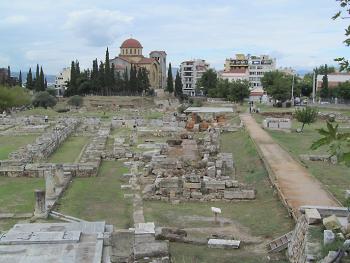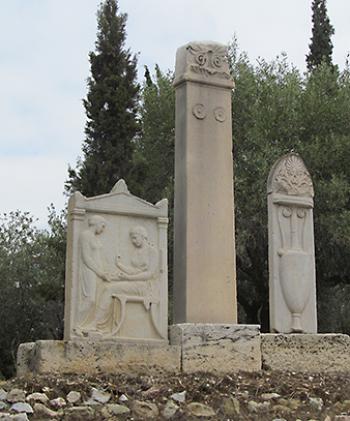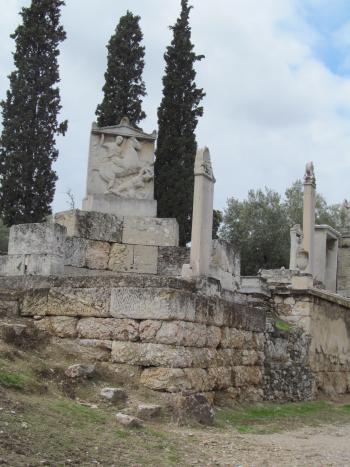Kerameikos: Athens’ ancient cemetery
This item appears on page 24 of the January 2022 issue.
KERAMEIKOS: Athens’ ancient cemetery
I am standing in Kerameikos, one of Athens’ oldest cemeteries. At first the site seems lonely, even desolate, somewhat like my life since COVID-19 sidetracked me after March 2020.
Back then, I had just returned from a long trip to New Zealand and Australia, with my mind full of memories and my suitcases full of souvenirs. I was already planning new trips to Greece, to France and to Italy in the coming months. I imagined meandering through the Plaka in Athens, strolling along the Promenade in Nice, joining the evening passeggiata in Rome’s Piazza Navona. Of course, there would be archaeological sites to revisit, some not seen in many years.
This was not to be. COVID-19 and travel restrictions intervened. Plans were postponed a number of times or just canceled outright.
Now, with restrictions having eased a bit, here we finally were — my husband, Paul, and myself — newly arrived in Athens at the start of a 32-day trip in October-November 2021. Why I picked Kerameikos as the first Athenian site to visit I have no idea. Possibly because I had never visited it before. Also, Kerameikos is not often on anyone’s “must see” list, so I suspected it would be uncrowded. It was.
Kerameikos has a long history. Some sources claim that pottery makers settled here beside the Eridanos stream, because of its good clay deposits, perhaps as far back as 5,000 years ago. Our English word “ceramics” derives from the Greek word keramiká, meaning “pottery” or “potter’s clay.” But by the 7th century BC, Kerameikos had become Athens’ main burial ground, with tombs and memorials occupying the area.
Burial customs
There were burials in Kerameikos as early as the 12th century BC in pit-like cist graves. In fact, some sources claim that there were burials a thousand years and more before the 12th century BC. Burial customs changed, and cremation became common, with ashes put into urns that were then placed in pits.
In the 10th century BC, stone stele appeared as markers over grave pits, followed later by vase-shaped memorials erected over grave sites. In the 7th and 6th centuries BC, earth mounds were raised over family graves.
By the 5th to 4th centuries BC, memorials embellished with sculptures were erected over graves, although in an edict imposed by Demetrius of Phaleron sometime during his reign, 317-307 BC, this practice was forbidden by law as being extravagant. The ban lasted through the Hellenistic period.
Burials in Kerameikos continued well into the Roman era, a lengthy period of time in Greece that began in the mid-2nd century BC and lasted until AD 476.
Funeral memorials
It is the replicas of elaborate memorials of the 5th and 4th centuries BC that most visitors to Kerameikos come to see. Many of these memorials line the Street of Tombs close to the entrance to the archaeological site. (The originals are in Kerameikos’ on-site museum and in Athens’ National Archaeological Museum.)
One of the first memorials seen as one walks downhill toward the Street of Tombs is the marble grave memorial of two sisters, Demetria and Pamphile, that dates from the end of the 4th century BC.
A few steps away, numerous memorials stand shoulder to shoulder on the Street of Tombs itself. Two to note especially are the 4th-century-BC tomb of Dionysios of Kollytos, topped by a magnificent large bull, and the marble grave relief of Dexileos, who died in battle in 394/393 BC. It shows the young soldier slaying his enemy from atop a rearing horse.
The domed church close by picturesquely framed by towering cypresses is Agia Triada (Holy Trinity), one of many Byzantine-style churches dotting Athens.
Eleusinian procession
The Street of Tombs leads into the Sacred Way, the route that once passed through the nearby Sacred Gate and ended at Eleusis 12 miles away.
Annually in the month of September, a procession began in the Agora through the Sacred Gate, wending its way to the sanctuary where the Eleusinian religious rites were celebrated. These rites revolved around the cult of Persephone, who was abducted by Hades, god of the underworld, and Demeter, her mother, who bargained to have her daughter return to Earth half the year. With Persephone’s return to Earth came spring. With her departure to the underworld, fall and winter began.
Very little remains of the Sacred Gate originally built by Themistocles, the Greek politician and general, in 478 BC after the Greeks defeated the Persians at the Battle of Marathon in 490 BC. There is a colony of turtles who live here — and elsewhere in Kerameikos — who spend their time devouring the tiny dandelions and skirmishing among themselves. They appear to be a big attraction for visitors.
Panathenaic procession
The other important gate within the present-day borders of Kerameikos is the Dipylon Gate, erected also by Themistocles as part of his fortification of Athens. The largest gate leading into the city, it was spacious enough to accommodate crowds but also meant as protection for the city, with sturdy towers flanking its entrance.
It was at the Dipylon Gate that the Panathenaic procession assembled in August to march to the Acropolis to honor Athena, the city’s protector. This procession is depicted on the frieze of the Parthenon. (The frieze is on view in London’s British Museum. Fragments are also displayed in Athens’ Acropolis Museum.)
Between the two gates stood the Pompeion. With an outer monumental gate called the propylon, a large inner courtyard and banqueting rooms, it was where participants in the Panathenaic procession assembled, dressed and banqueted during the festivities.
Massive walls
At this end of Kerameikos, adjacent to the Pompeion and the ruins of the two city gates, are massive remnants of walls. After the second Persian invasion, which ended in defeat for the Persians in 480 BC at the Battle of Salamis, Themistocles ordered walls constructed of rubble, fragments of other buildings, even funerary monuments. These were erected to protect Athens against future attacks during the ongoing Greco-Persian Wars.
For more than 14 centuries, Kerameikos served as a cemetery. There is an aura of sadness (at least, there was for me) in strolling past memorials erected to Athenians long gone.
But long before the first burials here, Kerameikos was also the place where potters worked fashioning the vases we now admire in museums. It’s also where two of ancient Athens’ most important religious processions passed through. It was a place of life as well as of death.
If you go…
Kerameikos is located at 148 Ermou Street (phone 30 210 346 3552). It’s open 8 a.m.-8 p.m. April to October and 8-5 November through March. Admission costs €8 (near $9.25).
There is a small museum on site that visitors shouldn’t miss. It is full of exquisite pottery and grave memorials, including the original of the bull from atop the grave of Dionysios of Kollytos. F




